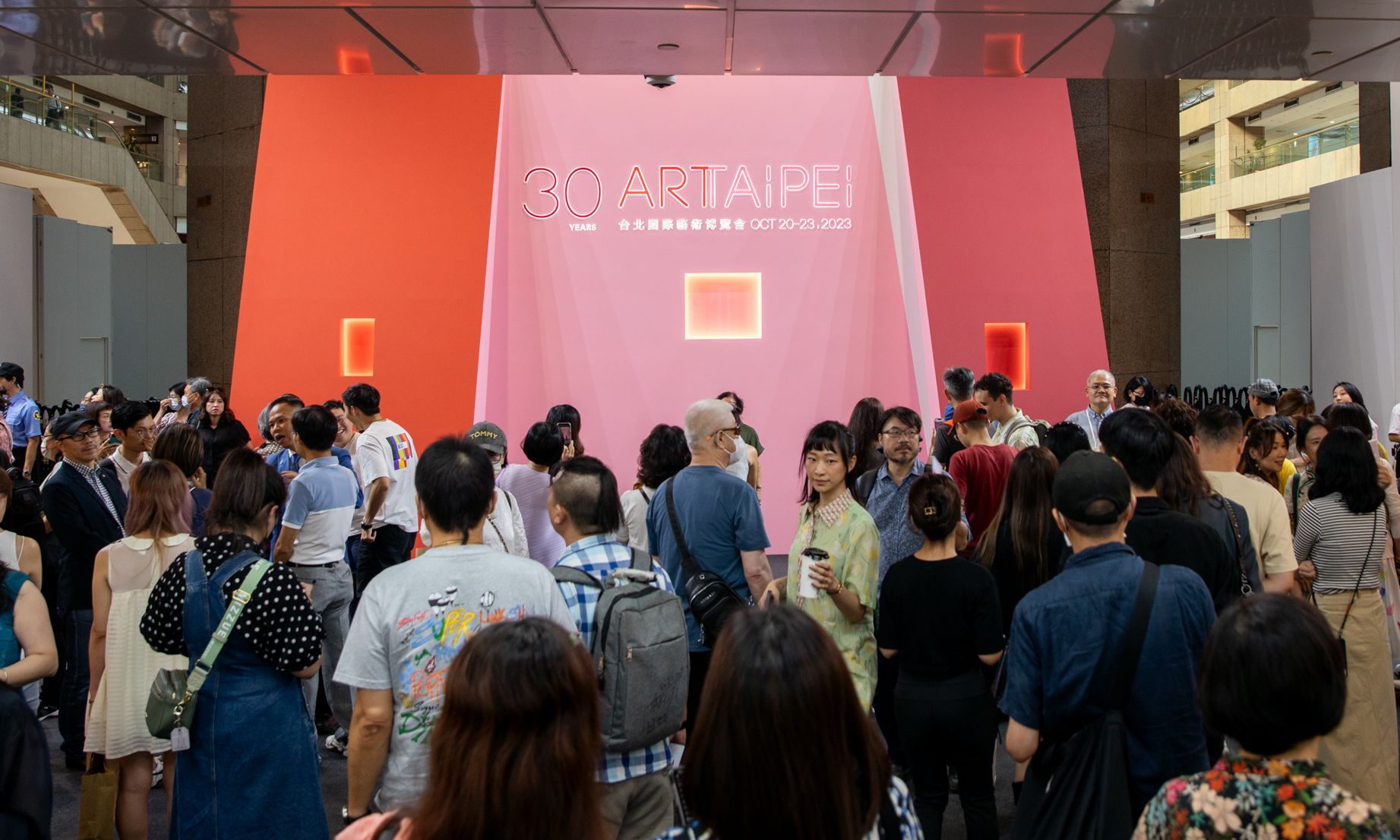Visitors to the 30th edition of Art Taipei
The 30th edition of Art Taipei, which ran from 19-24 October, opened at a complicated time for the island. This year marked the first iteration of the fair—one of Asia's oldest–since the lifting of strict border controls due to Covid-19, and the looming presidential election, which will be held in January 2024, has been intensified by sabre-rattling from mainland China.
While Taiwan is weathering the economic malaise facing the East Asian region better than many of its neighbours, projects like Art Taipei feel an additional squeeze from a proliferation of big events on Asia’s art calendar that siphon off galleries, collectors and cache. Despite Taiwan’s excellent state museums, strong galleries, top collectors and long history of art, film and music, it has struggled to build a reputation as a leading Asian cultural capital, and is one of the few regional scenes without a co-ordinated annual art week.
“Taiwan only established its cultural department in 2012,” says Oliver Chang, the director of Art Taipei and its parent organisation, the Taiwan Art Gallery Association (TAGA). “Taiwan is much more focused on technology, not art; culture is not a policy priority. So it is on us to push for it.” Chang describes TAGA as a “citizen nonprofit”, which exerts what sway it can to encourage things like lowering taxes on imported art and pushing for a formal art appraisal system, the latter of which is finally being put into motion after two decades of pressure. “We are talking to the ministry of culture about what other countries are doing,” Chang says, “but the movement is too slow!”
This Art Taipei saw the convening of the Asia Pacific Art Galleries Association (APAGA), which includes groups from Singapore, Hong Kong, Japan and Indonesia; the association in South Korea organises the Korea International Art Fair (Kiaf). The gallery groups met with Taiwanese government representatives to discuss projects and policies back home. In Taipei, Chang says, "we want an art week, but the major art museums are all government-backed, so we can’t do it ourselves".
Currently, the island's art calendar sprawls between Art Taipei in October, the Taipei Biennale, at the government-run Taipei Fine Arts Museum, in November, and Taipei Dangdai in May. “We lack the government support that Korean and Singaporean arts get,” Chang says, with Taiwan’s total cultural budget equivalent to what Korea spends on fine art alone. Rather than coordinate efforts or overhaul taxes, the cultural ministry has focused on “sustainable art”, using blockchain carbon taxes as a currency for art purchase.
An overlap with the Paris Art Week made little impact on the packed corridors of opening day (19 October), and the fair drew more than 70,000 visitors over its five-day run time, says a fair spokesperson. According to Claudia Chen, director of Taipei’s Liang Gallery, “the art market in Taiwan is considered mature in the Asian region due to high GDP and high income entrepreneurs, particularly from the electronics industry”. Liang represented one of a handful of regionally established local galleries joining the fair this year, while many of the city’s biggest marquee dealers like Tina Keng and Eslite in recent years have eschewed Art Taipei for Taipei Dangdai, organised by international fair group The Art Agency. For decades, Taiwan’s “entrepreneurs purchase art through auctions, [while] medium-sized business owners and private collectors [make] their art purchases at art fairs,” Chen says.
Chen compares Art Taipei favourably to other fairs that the gallery partook in this year like Art SG, Art Basel Hong Kong and Taipei Dangdai. Liang’s total sales at the fair rose 30% from last year, Chen says. She praises the diversity of collectors and high local visibility, although she adds that fielding basic questions "can occasionally be time-consuming". A TAGA visitor survey found that 57% of collectors had been attending exhibitions for less than three years and that 58% were under the age of 44.
As a gallery association fair, Art Taipei "cannot be highly selective about the participating galleries", Chen observes. "Some top galleries seeking a more high-quality or refined art fair experience may choose not to participate." Ink art and saccharine cartoon illustrations dominate the offerings. This year 144 galleries were selected from 170 applicants. Standouts included Labay Eyong‘s sculptures in a section highlighting Indigenous Taiwanese artists, and a presentation on ink art history in Taiwan, which featured works by Li Hua-Sheng and Yuan Hui-Li. 'Made In Taiwan', a government-funded focus initiated in 2008, included one of the only photographic offerings Breathing in New York, September 2022, of Yu-Ching Wang’s performances examining anti-Asian hostilities during Covid-19, shown by the local gallery Chini.
The fair spokesperson observes that offerings are cautious this year in part because "Taiwan is currently facing a presidential election and an economic downturn". The Democratic People’s Party (DPP) incumbent Tsai Ing-wen completes her term next year. Her vice president William Lai Ching-te is running to replace her, and will face off a squabble of opponents who will likely split support for the main opposition, the Kuomintang (KMT). Traditionally, the DPP has advocated for a more distinct Taiwanese identity, while the KMT stresses the dominant ethnic Han population’s roots in China, though those distinctions have become blurred with a younger generation. “Most collectors tend to be more conservative in such circumstances, and Taiwanese collectors often seek art acquisitions abroad where galleries better understand their preferences,” the spokesperson adds.
Art Taipei this year hired Shanghai-based arts PR P.art Group to bring about 20 members of the mainland Chinese, plus a handful of collectors to the fair, despite an onerous application process that only yields a few days’ visit via indirect flights. Chang says the outreach was put in place due to Taiwan and mainland China's mutual language, a desire to interact more with the mainland art world, and because Taiwan’s ties with the art scenes of Japan and Korea are already strong. "We have to try very hard because of the visa problem, and political things."

